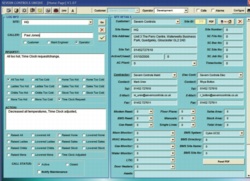Putting the E back into BEMS

A BEMS bureau integrated with BEMS sub-metering can profile energy consumption using automated metering and targeting.
Paul Bolton suggests that a BEMS will become inefficient within two to three years unless it is actively monitored and that the customer will miss out on valuable information that can saved energy, man hours and money — problems that can be avoided with the help of a BEMS bureau.When commodity prices were stable, having a building controlled, even if it was not controlled efficiently, was for many organisations the main benefit of a building-management system. However, the rising cost of energy suggests a return to BEMS (building and energy-management systems) and the need to focus energy-saving technologies. A typical BEMS installation properly configured, commissioned and maintained should create energy savings of at least 20%. However, this level of saving relies on the system being properly configured, commissioned and maintained; in many cases ‘set and forget’ is the reality. Without an in-house engineer to monitor the system, maintain setpoints and time clocks, note alarm conditions and faults and take action, what are the options? The sensible answer is to employ a ‘virtual energy manager’ in the form of the latest generation of BEMS bureau. Using sophisticated software and highly trained operators, a bureau will bring together all the elements of the BEMS jigsaw, and more, to form a complete picture. Like all good pictures, the deeper you look into it the more you see and understand. Take as an example, a local store in a national retail chain. On a day-to-day basis, a bureau removes local control of HVAC and other services by providing operators to monitor, adjust and advise on every aspect of a BEMS and the mass of equipment that keeps it operating efficiently. Let us, for example, imagine that one of the store’s temperature sensors is damaged and provides a sub-zero reading that forces the heating system to over-compensate, creating an uncomfortable environment and wasting huge amounts of energy. The only way local staff could deal with the situation is to switch off. However, a bureau operator can connect to the store, switch off the damaged sensor and adjust nearby sensors to balance the heating system. This temporary solution achieves a comfortable compromise until an engineer (alerted to the fault by the bureau via e-mail) can replace the sensor. As the system is balanced, the visit need not be an emergency call-out. Significantly, such an incident may even cover the annual cost of the bureau — which, in many cases, is the equivalent of a single service call by a maintenance engineer. This may sound unbelievable, yet without the information provided by the bureau, the same fault could have taken three visits to identify and rectify — and cost three times more than one year of bureau monitoring! This is the reality of a ‘virtual energy manager’, and faults are often rectified before the store manager even knows there is a problem. Even greater benefits are derived when a bureau is integrated with BEMS sub-metering. It then becomes, in effect, an energy-targeting system that profiles consumption using automated metering and targeting (AM&T) to produce a league table of energy consumption of different items of plant, different stores etc. Where a bureau differs from an external metering service is the operator’s ability to then identify anomalies and take the necessary action to rectify them.

Sophisticated software and highly trained operators enable a BEMS bureau to bring together all the elements of the BEMS jigsaw.
Staying with the retail scenario, the bureau operator can identify stores with HVAC faults that are above-average, and by then interrogating the software, review specific air-conditioning units, report on failure rates and show whether faults are the same or different. The results may highlight a manufacturing issue, prompt a review of air-conditioning units in other stores and even suggest training if the same engineer is repairing a recurring fault. Bureau software can also log simple health-and-safety activities such as regular testing of emergency-lighting circuits and fire-alarm systems, to show that stores are conforming to regulatory standards. Conforming to Part L of the Building Regulations (conservation of fuel and power) is also simplified by monitoring and recording the use of gas and electricity. In effect, the bureau monitors and safeguards the health and safety of the building. A bureau can monitor new or existing BEMS installations. However, monitoring existing systems first requires a thorough audit of a site as, over the years, additional plant may not have been connected to the BEMS. A complete re-commissioning is also essential to ensure that all equipment that can be controlled is brought into the BEMS and monitored by the bureau to ensure that, in future, as little energy as possible is used to meet business objectives. Summing up, whether you operate multiple outlets or highly complex sites, a factory or shop, a hotel or hospital, energy saving is, and will continue to be, a major incentive for employing a bureau. But I hope I have convinced you that its true potential is significantly greater. Paul Bolton is managing director of Severn Controls
Related links:
Related articles:









